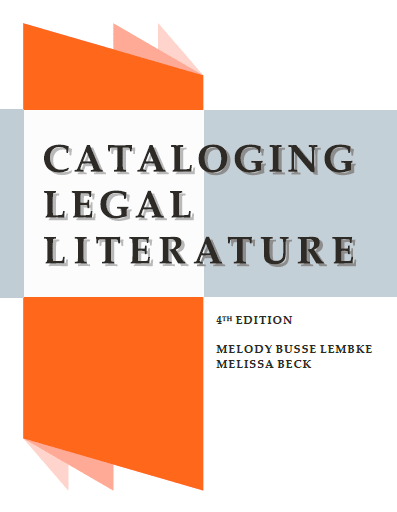Revision 1 to Cataloging Legal Literature 4 Just Issued!
<Sigh of relief, appropriate emoticon>. I managed to issue a “real” continuing resource this time, and not just a treatise in a binder that never got updated as with CLL3 in 1997. Kudos to co-author Melissa Beck and Hein’s Sheila Jarrett for keeping us on track! What happened during that big gap between CLL3 and CLL4? I wasn’t just twiddling my thumbs waiting around for AACR3 to appear; I was sitting at one sports field or another as my sons made it through school. For those of you that can remember me dragging babies to AALL meetings, here’s something to make you feel real “experienced.” My oldest is turning 30 this week! The youngest son works for Riot Games which has really ruined my mother’s mantra of: “you’re wasting your time playing all those video games!” He’s paid for gaming; he’s a gameplay capture artist! How’s that for a 21st century possible $e?

After so much time and change, how does one decide what to cover about legal literature? We tried to focus on those areas that caused the most consternation and head scratching for law catalogers. The biggest change for all of us has been our digital collections. My recommendation would be that if you are struggling to deal with electronic resources, pick up the paper version and read chapters 3 and 4. If you’ve never done any law cataloging, please don’t skip Chapters 1 and 2. Regardless of cataloging code, those introductory chapters will help establish your baseline understanding so you can describe and apply subject and classification to legal stuff going forward.
How can you use the online version of CLL4? Keep in mind that Part 2 is the only place that so much disparate stuff is brought together for law materials. I use Part 2 all the time. Don’t think that just because I wrote or captured this info that I can remember it all! Yesterday I did a quick look-up to double check on the correct use of the genre heading Legal Forms. A reference takes you to Forms in the A-Z list where we have the explanation that the genre is used even when the work you are cataloging isn’t all forms.

So what is in this first revision? A place to record what the revisions contain is now located at the end of the A-Z list.

I’m also happy to say that with this revision there is now some official info on establishing International court names in RDA and CLL4, part 2. My IU MLS cataloging instructor, D. Katheryn Weintraub, once put me on the spot by asking at a conference: “Why I hadn’t written anything about international court name construction in CLL?” She had identified them as problematic when she was working on “Problems of Corporate Entries.” She is also the one responsible for my proclivity for diagramming cataloging rules (aka instructions): see Appendices in Part 1. These diagrams can be very handy shortcuts when explaining legal literature access under RDA to others.
Please let us know how you are using CLL4 or if you have questions. Use the “Leave Feedback” button along the top display bar to keep in touch, which is the closest we could get to a Snapchat for law cataloging.




